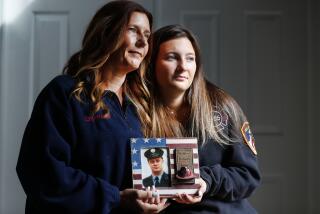Inspiration Sought in Horror : Oklahoma City wants memorial designers to feel bomb victims’ pain.
- Share via
OKLAHOMA CITY — The survivors of the April 19, 1995, attack on the Alfred P. Murrah Federal Building want you to feel their pain. Especially if you’re among the hundreds of architects--novice and professional--who have begun submitting blueprints for the Oklahoma City Memorial international design competition.
“We don’t want just a piece of cold marble out on the ground,” said Jannie Coverdale, whose two grandsons, 5-year-old Aaron and 2-year-old Elijah, were killed in the blast. “We want something with feeling.”
Lest that message be lost on any aspiring monument-crafters, Oklahoma City officials unveiled an unusual multimedia exhibit Monday in the ruins of the Murrah parking garage. Open only to participants in the design contest, it is intended to re-create the horror and heroics of the bombing--to ensure that competitors “taste it and smell it,” according to Tom Toperzer, head of archives for the city’s recovery effort.
“Everything in here is real,” Toperzer added before shepherding reporters through the exhibition space, a series of three cinder-block rooms that once housed the government’s motor pool office.
Just inside, a mound of debris spills across the floor: A toppled file cabinet. A torn phone book. A swath of yellow police tape.
On the walls, larger-than-life photos stretch from head to toe: Panicked children. Smoldering wreckage. Weary firefighters.
Newscasts of the chaotic minutes after the attack flash across nine video monitors. An audiotape of a state Water Resources Board meeting, which was being held across the street from the federal building, erupts in a churning, billowing wave of noise.
In the next room, there is a cot, the kind used by rescue workers, with a rose and a red bandanna lying next to the pillow. Above it, dozens of origami cranes dangle from the ceiling. In the last room, there is a shrine of flowers and flags and stuffed animals, all collected from the bomb site. A tally of 168 deaths is etched on the wall and a recording of Bette Midler’s “Wind Beneath My Wings” plays on without end.
“Strong,” said Toperzer, assessing the emotional impact. “I think we’re getting our point across.”
Nobody ever accused Oklahoma City of being in denial. In the last 22 months, victims and survivors and sympathizers have presided over a steady parade of homages and dedications and prayer services. But Monday’s exhibit--designed solely to infuse contestants with the “experiential nature” of the disaster--seemed more cathartic than most post-bombing events.
From the beginning, the quest for a lasting tribute has been treated almost as a sacred mission.
A 350-member task force spent eight months soliciting input, asking the public “what this memorial should feel like, not look like, but what the experience should be,” said Karen Luke, vice chairwoman of the Oklahoma City Memorial Foundation.
*
More than 10,000 people responded, showing up at community forums and sending messages via the Internet. A set of guidelines, adopted last March, envisions a “world-class symbolic memorial” that recognizes “the impact of violence” but also offers “comfort, strength, peace, hope and serenity.”
A call for designs, open to anyone with the $25 filing fee, went out in November. Entries will be accepted until Feb. 10. More than 600 submissions have been received, from 41 states and three countries, contest officials said. Three to five finalists will be announced on April 19. The winner, who will have an $8.8-million budget, is to be named on July 3.
More to Read
The biggest entertainment stories
Get our big stories about Hollywood, film, television, music, arts, culture and more right in your inbox as soon as they publish.
You may occasionally receive promotional content from the Los Angeles Times.










